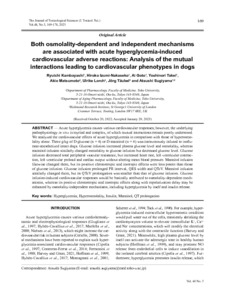Kambayashi, R; Izumi-Nakaseko, H; Goto, A; Takei, Y; Matsumoto, A; Lorch, U; Täubel, J; Sugiyama, A
(2023)
Both osmolality-dependent and independent mechanisms are associated with acute hyperglycemia-induced cardiovascular adverse reactions: Analysis of the mutual interactions leading to cardiovascular phenotypes in dogs.
J Toxicol Sci, 48 (3).
pp. 169-178.
ISSN 1880-3989
https://doi.org/10.2131/jts.48.169
SGUL Authors: Taubel, Jorg
![[img]](https://openaccess.sgul.ac.uk/115617/1.hassmallThumbnailVersion/231.%20Kambayashi.pdf)  Preview |
|
PDF
Published Version
Available under License ["licenses_description_publisher" not defined].
Download (1MB)
| Preview
|
Abstract
Acute hyperglycemia causes various cardiovascular responses; however, the underlying pathophysiology in vivo is myriad and complex, of which mutual interactions remain poorly understood. We analyzed the cardiovascular effects of acute hyperglycemia in comparison with those of hyperosmolality alone. Three g/kg of D-glucose (n = 4) or D-mannitol (n = 4) was intravenously infused to isoflurane-anesthetized intact dogs. Glucose infusion increased plasma glucose level and osmolality, whereas mannitol infusion similarly changed osmolality to glucose infusion but decreased glucose level. Glucose infusion decreased total peripheral vascular resistance, but increased heart rate, left ventricular contraction, left ventricular preload and cardiac output without altering mean blood pressure. Mannitol infusion likewise changed them, but its positive chronotropic and inotropic effects were less potent than those of glucose infusion. Glucose infusion prolonged PR interval, QRS width and QTcV. Mannitol infusion similarly changed them, but its QTcV prolongation was smaller than that of glucose infusion. Glucose infusion-induced cardiovascular responses would be basically attributed to osmolality-dependent mechanisms, whereas its positive chronotropic and inotropic effects along with repolarization delay may be enhanced by osmolality-independent mechanisms, including hyperglycemia by itself and insulin release.
| Item Type: |
Article
|
| Additional Information: |
© 2023 The Japanese Society of Toxicology |
| Keywords: |
Hyperglycemia, Hyperosmolality, Insulin, Mannitol, QT prolongation, Dogs, Animals, Cardiovascular System, Hyperglycemia, Glucose, Mannitol, Phenotype, Cardiovascular System, Animals, Dogs, Hyperglycemia, Mannitol, Glucose, Phenotype, Hyperglycemia, Hyperosmolality, Insulin, Mannitol, QT prolongation, Toxicology |
| SGUL Research Institute / Research Centre: |
Academic Structure > Molecular and Clinical Sciences Research Institute (MCS) |
| Journal or Publication Title: |
J Toxicol Sci |
| ISSN: |
1880-3989 |
| Language: |
eng |
| Dates: |
| Date | Event |
|---|
| 1 March 2023 | Published | | 29 January 2023 | Accepted |
|
| Publisher License: |
Publisher's own licence |
| Projects: |
|
| PubMed ID: |
36858642 |
| Web of Science ID: |
WOS:000942508500006 |
 |
Go to PubMed abstract |
| URI: |
https://openaccess.sgul.ac.uk/id/eprint/115617 |
| Publisher's version: |
https://doi.org/10.2131/jts.48.169 |
Statistics
Item downloaded times since 19 Sep 2023.
Actions (login required)
 |
Edit Item |



